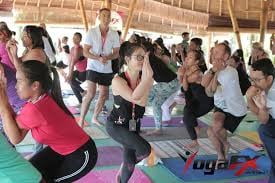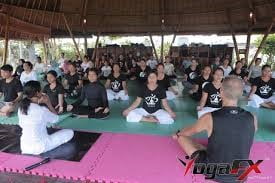“Guru yoga” are two Sanskrit words. We have to see what do they mean.
What is a Yoga Instructor Called? A popular etymological theory considers the term “guru” to be based on the syllables gu and run, which it claims stands for darkness and “light that dispels it”, respectively. The guru is seen as the one who “dispels the darkness of ignorance.”
Remender Kranenborg disagrees, stating that darkness and light have nothing to do with the word guru. He describes this as folk etymology.
Joel Mlecko states, “Gu means ignorance, and Ru means dispeller,” with guru meaning the one who “dispels ignorance, all kinds of ignorance”, ranging from spiritual to skills such as dancing, music, sports, and others. Karen Pechelis states that, in popular parlance, the “dispeller of darkness, one who points the way” definition for guru is common in the Indian tradition.
In Western Esotericism and the Science of Religion, Pierre Giffard makes a distinction between “occult” and “scientific” etymologies, citing as an example of the former the etymology of ‘guru’ in which the derivation from gu (“darkness”) and ru (‘to push away’); the latter he exemplifies by “guru” with the meaning of ‘heavy’.
A guru is a very fully qualified spiritual master.
The word literally means someone heavy, meaning with a great deal of weight of good qualities.
The term is translated into Tibetan in various ways. One is the word “lama” (bla-ma), which again means a very highly master, although the term is used in different Tibetan-type cultures in many different ways with lesser meanings. So, in some Tibetan cultures, “lama” refers to any monk. We certainly do not mean that with guru-yoga. And in other cultures, it can be somebody who has just done a three-year retreat, which just means that they have become qualified to be a village priest and do rituals. We certainly don’t mean lama with that. And then some Western people just declare themselves “lama” just pretentiously for various reasons – which might not be the purest. We certainly don’t mean that.
Yoga aims to realize that we are all connected. We share one heart, one consciousness, and one Divine Source. Yoga’s method is to provide us with experiences that help us grasp this. To realize that we are all connected, it is helpful to connect to one other person. In the yogic tradition, this connection is experienced through a relationship with a guru, a teacher who facilitates the awakening of unitive consciousness. By acknowledging a guru, you connect to those who have trod the path before you. In doing so, humility dawns, and awakening is possible.
The concept of guru is difficult for most Westerners to accept because we like to think we are in charge. But the truth is that the predominant powers in our society control most people’s lives. Big corporations and the advertising agencies that work for them decide what people think about and shape our society’s values. There’s no one in school who teaches us methods to gain genuine control over our lives; instead, emphasize working for material gain. Most of us are at the mercy of our emotions, and when we can’t handle them we use alcohol or other drugs, TV, shopping, eating, or sex to make ourselves feel happier. The idea that lasting happiness can be found inside, without having to buy, smoke, eat, watch, or drink anything is foreign to us. We may need a translator. The guru is the translator.
Gurus do not necessarily have to be Indian, or enlightened. They may be married or not. They may have regular jobs and not head an ashram. A guru is a teacher who imparts to you insights or revelations about Yoga. A guru may also give you a method to practice so that you may realize for yourself the truth of those revelations.
For someone to be your guru you must acknowledge him or her as such. A guru may not proclaim to you “I am your guru.” That is for the student to proclaim. Once that acknowledgment and appreciation dawn, learning accelerates. Gurus do not require, as some in the West mistakenly believe, to take that blood oaths or turn over that all worldly possessions.
You will be taught according to your capacity to learn. So to find a guru become the perfect disciple. Become irresistible to the guru by becoming empty. When you come before a teacher set aside “I know” so that you can be taught. If you are already filled up with knowledge, like a cup full of tea, and your teacher attempts to pour new tea into your cup, you will just overflow and no benefit will be obtained.
In this tradition, knowledge passes from guru to disciple in a continuous, uninterrupted flow. The relationship of guru and student must have a particularly pure quality for the transmission to take place. Respect and love for the teacher must be understood as the same as respect and love for the Divine. This can be challenging, especially for westerners.
The guru tradition is based on humility and appreciation. The respect a student gives a teacher is not for the teacher’s benefit; it benefits the student to acknowledge and bow to another because this opens the connection to the Self within the student. It may help to think of the Guru as a force rather than a person.
The guru teaches, inspires, disciplines, forgives, parents, models, and transmits the truths of life.
CLICK HERE For More Course Inclusions and Our June Main Event![]()





















































